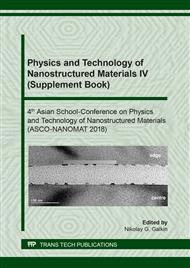[1]
G. Gille, B. Szesny, K. Dreyer, H. van den Berg, J. Schmidt, T. Gestrich, G.Leitner, Submicron and ultrafine grained hardmetals for microdrills and metal cutting inserts, International Journal of Refractory Metals & Hard Materials. 20 (2002) 3–22.
DOI: 10.1016/s0263-4368(01)00066-x
Google Scholar
[2]
Z.Z. Fang, Correlation of transverse rupture strength of WC-Co with hardness, International Journal of Refractory Metals & Hard Materials. 23 (2005) 119-127.
DOI: 10.1016/j.ijrmhm.2004.11.005
Google Scholar
[3]
C. McVeigh, V.K. Liu, Multiresolution modeling of ductile reinforced brittle composites, Journal of the Mechanics and Physics of Solids. 57 (2009) 244-267.
DOI: 10.1016/j.jmps.2008.10.015
Google Scholar
[4]
S. Honle, S. Shmauder, Micromechanical simulation of crack growth in WC/Co using embedded unit cells, Computational materials science. 13 (1998) 56-60.
DOI: 10.1016/s0927-0256(98)00045-7
Google Scholar
[5]
U. A. Ozden, G. Chen, A. Bezold, C. Broeckmann, Numerical Investigation on the Size Effect of WC/Co 3D Representative Volume Element Based on the Homogenized Elasto-Plastic Response and Fracture Energy Dissipation // Key Engineering Materials. 592-593 (2014) 153-156.
DOI: 10.4028/www.scientific.net/kem.592-593.153
Google Scholar
[6]
M.H Pech., H.F. Fischmeister, D. Kaute, R.Spiegler, FE-modellig oft he Deformation behaviour of WC-Co allos, Computational materials science. 1 (1993) 213-224.
DOI: 10.1016/0927-0256(93)90013-d
Google Scholar
[7]
H., Engqvist, U.Wiklund, Mapping of mechanical properties of WC-Co using nanoindentation, Tribology Letters. 8 (2000) 147-152.
Google Scholar
[8]
C.S. Kim, T.R. Massa, G.S. Rohrer, Modeling the relationship between microstructural features and the strength of WC-Co composites, International Journal of Refractory Metals & Hard Materials. 24 (2006), 89-100.
DOI: 10.1016/j.ijrmhm.2005.04.011
Google Scholar
[9]
M.I. Dvornik, E.A. Mikhailenko, Modelirovaniye protsessa rasprostraneniya treshchiny v submikronnykh i nanostrukturnykh tverdykh splavakh, Mekhanika kompozitsionnykh materialov i konstruktsiy. 20 (2014) 3-15.
Google Scholar
[10]
V.A. Franklin, T. Christopher, Fracture Energy Estimation of DCB Specimens Made of Glass/Epoxy: An Experimental Study, Advances in Materials Science and Engineering. (2013) 1-7.
DOI: 10.1155/2013/412601
Google Scholar
[11]
F. Felten, G.A. Schneider, T. Sadowski, Estimation of R-curve in WC/Co cermet by CT test, International Journal of Refractory Metals & Hard Materials. 26 (2008) 55-60.
DOI: 10.1016/j.ijrmhm.2007.01.005
Google Scholar


